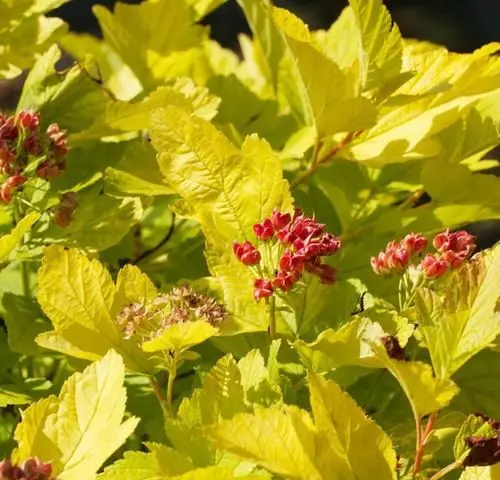Contents
The Little Angel vesicle is a low-growing perennial ornamental shrub with unusually colored leaves. The plant is unpretentious in care and has increased winter hardiness. It is used for landscaping playgrounds, gardens, park areas, front gardens. Little Angel looks spectacular in both group and single plantings, and retains its decorative effect throughout the season.
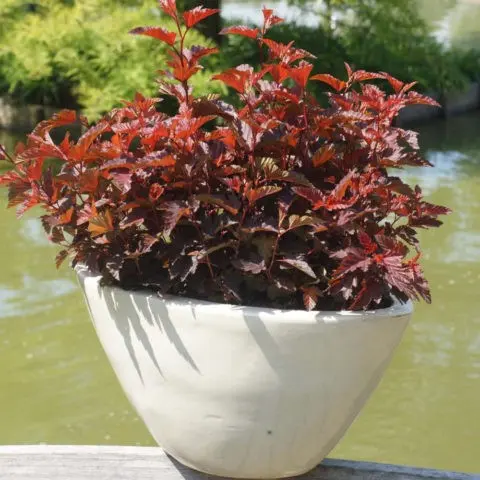
Description of the vesicle Little Angel
This variety of culture is a low-growing deciduous shrub, 0,8-1 m high. According to the description, the Little Angel vesicle forms a lush, rounded crown with numerous brown shoots. The plant is characterized by whole 3-5 lobed leaves, on which the middle share is noticeably distinguished. Young leaves have an orange-red hue, but as they grow and develop, the color changes and becomes a rich burgundy.
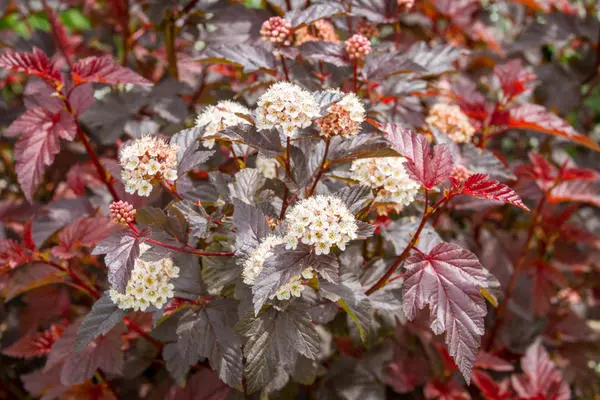
Flowering Little Angel occurs in the second half of June – early July. At this time, the plant forms dense corymbose inflorescences, consisting of small white-pink flowers. The fruits appear in August-September and are swollen leaflets that remain on the shoots for a long time.
Vesicle Little Angel in landscape design
This variety of culture is used to create a border or hedge. Judging by the reviews, photos and descriptions, the Little Angel vesicle also looks impressive in single plantings against the background of a green lawn, around water bodies, in rock gardens, flower beds and mixborders.
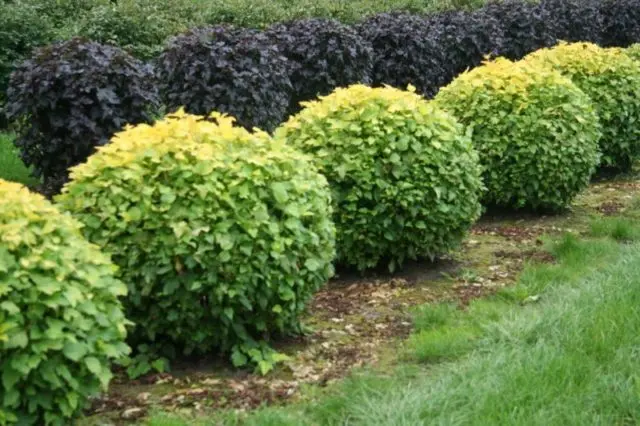
To decorate the garden, it is recommended to place this undersized variety in the foreground, and in the second – the vesicle Physocarpus opulifolius “Angel gold”, which is distinguished by a rich yellow tint of foliage. This technique will create a special contrast of colors and focus on the composition.
Conditions for growing the vesicle Little Angel
The Little Angel variety is fast-growing, it adds 20 cm in height per year. The plant is photophilous, but can withstand light partial shade. In the shade, the crown becomes loose, the shoots stretch, and the leaves lose their red-orange hue and turn green.
The Little Angel vesicle prefers to grow on well-drained sandy and loamy soils with a low level of acidity. It is drought-resistant and does not tolerate stagnant moisture in the ground.
Planting and caring for the Little Angel vesicle
The variety does not require special growing conditions. But compliance with the minimum rules of agricultural technology will significantly enhance the growth and development of the shrub, as well as improve the decorative properties.
Site preparation
Before planting the Little Angel vesicle, prepare the soil. To do this, you will need to dig the site 2 weeks before planting and carefully remove the roots of perennial weeds. During this period, the earth will have time to settle.
A planting hole is dug with a diameter of 30-40 cm and a depth of 50 cm. The nutrient topsoil is subsequently used to prepare a special mixture.
It includes the following components:
- 1 part humus;
- 1 part peat;
- 2 parts of soddy soil;
- 25 g of potassium sulfide;
- 20 g superphosphate.
Fill the landing pit by 2/3 of the volume with the resulting mixture in advance so that by the time of planting the layer can be compacted.
Rules of landing
It is possible to plant a vesicle of the viburnum Little Angel in a permanent place in spring, summer, autumn, excluding the flowering period. At the same time, the air temperature should not be lower than + 10⁰C, otherwise the plant will not be able to fully take root.
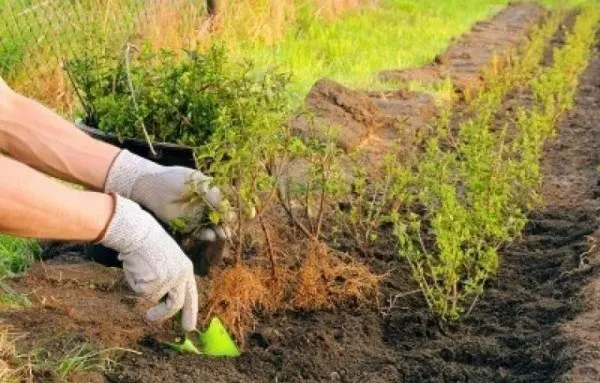
Algorithm of actions.
- Pour 5 liters of water into the planting hole and wait until the moisture is completely absorbed.
- Carefully remove the Little Angel seedling from the container, without disturbing the earthen ball and without straightening the roots.
- Place the plant in the center of the depression so that the root collar is 4 cm lower than the soil level. This stimulates the development of lateral dormant buds and thereby increases the diameter of the bush.
- Sprinkle with earth and compact the top layer. This will secure the vesicle.
- Pour the bush with a solution of “Kornevin”.
It is necessary to place the undersized Little Angel vesicle in group plantings at a distance of 35-40 cm. The distance to the nearest trees should be within 1,5-2 m.
Watering and top dressing
Moisturize the soil regularly after planting as the top layer dries. This will prevent the roots from drying out. In especially hot periods, it is recommended to mulch the planting circle with peat or humus with a layer of at least 5-6 cm. Place the mulch at a distance of 1-2 cm from the shoots so that the bark does not get steamed.
Top dressing is carried out in spring and autumn. In the first case, nitrogen fertilizers are applied when the buds open, which activates growth. In the second case – potash, for the full preparation of the plant for winter.
Trimming
As the bush grows, you need to form a crown. This will allow you to achieve maximum decorative effect. Formative pruning of the Little Angel variety is recommended in the spring before bud break or in the fall after the foliage has fallen. Young shoots should be cut at a height of 40-50 cm.
The Little Angel vesicle also needs sanitary pruning, which helps to clear the crown of broken, old and frozen branches. This procedure is carried out in the spring, when the air temperature is not lower than + 7-10⁰С, regardless of the time of day.
Preparation for winter
The Little Angel vesicle does not need additional shelter in winter. It is enough to sprinkle the root neck with an additional layer of earth or sawdust and compact.
The shrub is prepared for wintering when the air temperature drops to 0⁰С.
Reproduction
The vesicle variety Little Angel is propagated by cuttings and layering. These methods preserve species qualities.
To get new seedlings by layering, you need to bend the lower branches to the ground in the spring, fix them with hairpins and sprinkle with a layer of earth 10-15 cm. Leave the tops of the shoots on the surface and tie them to wooden pegs. You can plant young seedlings next spring.
With the help of cuttings, you can get a large amount of planting material. To do this, you will need to cut the shoots of the current year 20 cm long. Remove the lower leaves from the cuttings completely, and shorten the upper ones by half. Before planting, lightly scrape the bottom cut to promote callus formation. After that, place the cuttings in the rooting solution for a day, and then land at an angle of 45 degrees. Top with agrofibre or film to create a greenhouse effect. Cover the cuttings before wintering.
Young seedlings of Little Angel are transplanted to a permanent place after 2 years.
Diseases and pests
The pests of the Little Angel vesicle are the larvae of the May beetle, aphids and scoops. To combat them, systemic insecticides are used. Actellik helps to get rid of aphids. Processing is carried out according to the sheet in the morning or in the evening.
To destroy the larvae of the May beetle and scoops, the plants are watered with the Aktara solution.
The plant is affected by powdery mildew and anthracnose. For treatment, it is recommended to use Horus, Skor, Quadris.
Conclusion
The vesicle of Little Angel belongs to the category of those plants that are undemanding to care for. Due to this, the popularity of the variety is constantly growing. At minimal cost, you can create an unusual composition on your backyard that will delight the eye throughout the season.
